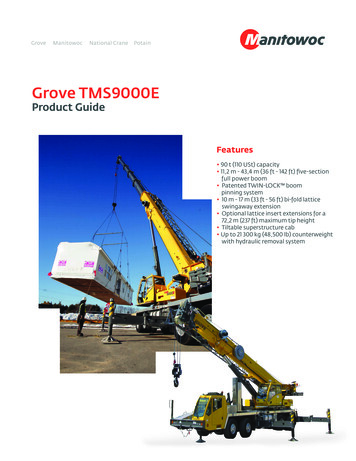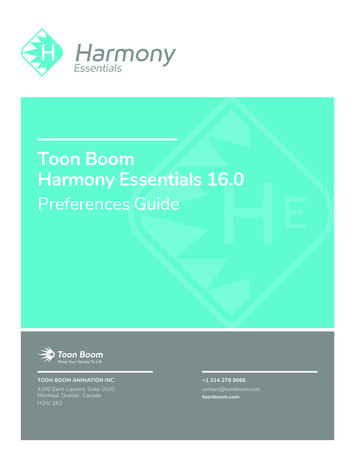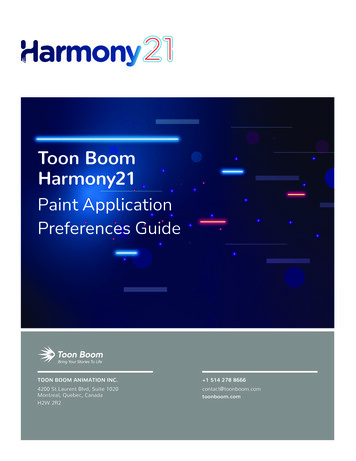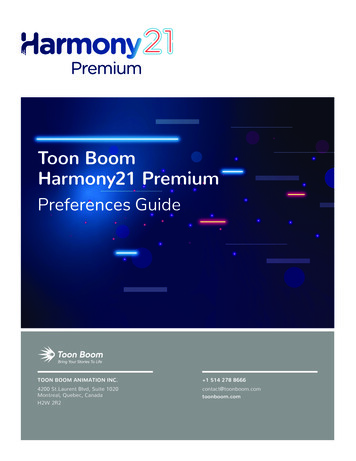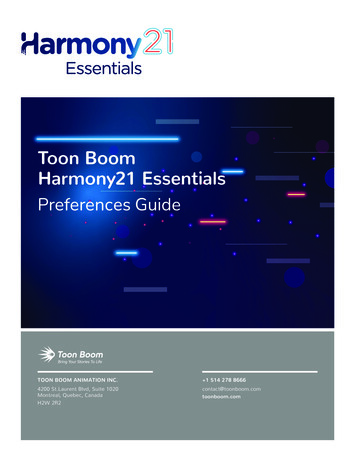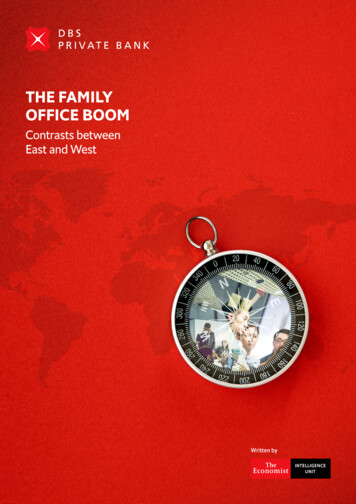
Transcription
The family office boom: Contrasts between East and WestTHE FAMILYOFFICE BOOMContrasts betweenEast and WestWritten by1
The family office boom: Contrasts between East and WestForewordFamily offices go wherever wealth goes. Whilst traditionally concentratedin the West, recent years have seen their emergence in Asia as theregion takes centre-stage as a global economic powerhouse. Against thisbackdrop, Singapore—an international financial centre and gateway toAsia’s opportunities—stands well-positioned to become a family office hub.According to the Monetary Authority of Singapore, the number of familyoffices in Singapore rose five-fold between 2017 and 2019.Compounding that growth is Asia’s maturing wealth landscape, which hassparked greater concern, conversation and demand for family office servicessuch as succession and legacy planning. Unlike their Western counterparts,which have existed for multiple generations, Asian family offices are relativelyyoung. Most are still in their first or second generation, and rely on thefamily business as their main vehicle for wealth generation. With familypatriarchs and matriarchs now ageing, we can expect to see a significantintergenerational wealth transfer over the coming ten to fifteen years.It is not possible to speak of trends driving the family office space withoutmentioning the Covid-19 pandemic. In just a matter of months, the pandemichas put the world on brakes and disrupted life as we know it to be—financialmarkets, communities, and businesses both large and small have beenaffected one way or another, and family offices are not spared either.Whilst there were differences in Western and Asian families’ responses toCovid-19, we also observed several commonalities. For one, the pandemictriggered a shared sense of vulnerability that prompted many families to deepdive into structural issues such as wealth protection and preservation, legacyplanning and family governance, which may not have been top-of-mind in thepast. We cannot over-emphasise the importance of these issues—especiallyso today, amidst intensifying populist sentiments and policies such as ‘QEInfinity’ by the US Federal Reserve, which suggest we are en route to a worldwith tightening regulatory regimes, and a possibility of higher wealth taxesand estate duties on the cards. Over the span of the last few months, we havebeen engaging more clients on these issues, helping them to plan better withstability and longevity in mind.The pandemic also prompted families to rethink their role in society. We havehad some clients share their intentions to help communities in their homecountries through these trying times, whilst others expressed interest in givingback through the likes of venture philanthropy, funding or mentoring socialenterprises, or setting up philanthropy trusts. We expect Covid-19 to pave the The Economist Intelligence Unit Limited 20203
The family office boom: Contrasts between East and Westway for families to place a more concerted focus on philanthropic endeavoursand also enable the next-gen, who tend to be more socially conscious, toadopt a bigger role and voice within the family business.Covid-19 is an unfortunate chapter, but one silver lining is that it has surfacedseveral key lessons for both Western and Asian families alike. As a trustedadvisor to these families, DBS Private Bank seeks to be a close partner at everystage of their wealth journey—helping them to create wealth and achievesuccess whilst navigating these learnings, and also live more enriched lives inthe process.We are pleased to support The Economist Intelligence Unit on this study,which takes a deeper look into the nuances of families in the East and West:their similarities and differences, the key factors driving these, as well as theirconcerns, priorities and outlook in today’s fast-changing world. We hope youfind this read insightful.Sim S. LimGroup HeadConsumer Banking & Wealth ManagementDBS Bank4 The Economist Intelligence Unit Limited 2020
The family office boom: Contrasts between East and WestAbout this reportThe family office boom: Contrasts between East and West is a report fromThe Economist Intelligence Unit, commissioned by DBS Private Bank.Family offices—personal investment firms for ultra-high-net-worth individuals(UHNWI)—are a growing force in the global financial market. The number offamily offices has increased ten-fold since 2008 and now stands at around10,000, according to consulting group EY.As the ranks of the world’s billionaires continue to expand, so too will thecount and assets of their associated family offices—along with their clout.The tradition of family offices was started in the West by wealthy British andUS businessmen. However, Asia has held a distinction as the world’s singlewealthiest region for the past five consecutive years.This report examines the different approaches of family offices in the East(the Asia region generally) and West (Europe and North America) and exploresthe role culture, family and wealth generation play in terms of their structureand management.The study is based on wide-ranging desk research and in-depth interviewswith family office owners, managers and advisers. Our thanks are due to thefollowing interviewees for their time and insights:Annie Chen, chair, RS Group, Hong KongStacy Choong, partner, private client and tax, Withers KhattarWong, SingaporeJoseph Falanga, managing director, UHY Advisors, USJames Fleming, chief executive officer, Sandaire, UKTony Gao Hao, director, Global Family Business Research Centre; anddirector, Strategic Partnership and Development Office, PBC School ofFinance, Tsinghua University, ChinaJames Grubman, owner, Family Wealth Consulting, USChompan Kulnides, vice-president of investment, Minor Holdings, ThailandChris Merry, group chief executive officer, Stonehage Fleming, UKProfessor Sir Anthony Ritossa, Chairman, Ritossa Family Office, DubaiKirby Rosplock, founder, Tamarind Partners, USProfessor Yu Hongru, founder, BOZE Family Office, ChinaThe report was written by Dewi John and edited by Georgia McCafferty andJason Wincuinas. The Economist Intelligence Unit Limited 20201
The family office boom: Contrasts between East and WestExecutive summaryThe distinction between East and West family offices is the main focusof this report. While a number of interviewees stressed that everyfamily office is as distinct as the family it represents, two universalfactors appear prominent for influencing practices: the culturalbackground of the family and the maturity of its wealth—whether it is“old money” or comes from more recent entrepreneurship.Within the family office world, a rule of thumb is that Europeanfortunes are generally older and inherited whereas wealth in Asia oftenfalls into new and entrepreneurial categories. This is all the more true inChina where private family fortunes saw a reset after the Communistand Cultural revolutions of the 20th century. Much of the availableresearch on the country’s high-net-worth individuals (HNWIs) agreesthat about 95% of billionaires in China today are self-made and haveacquired wealth within just the past two or three decades.Regardless of where on the compass a family office sits, its number-oneissue will always be succession planning. Still, there are contrasts. Inthe West, by far the largest amount of wealth will be moving betweengenerations over the next decade—some US 8.8trn in North Americaalone. Estimates for the East fall just short of US 2trn for the sametimeframe. But given the lower average age of the region’s HNWIs,the amount of wealth transfer in the East could grow rapidly and soonbecome an industry trend driver.Because the formal legal structures of the family office have a longerhistory in the West, the processes for managing successions arewell established. Cultural norms in the West—particularly directcommunication—also tend to favour a straightforward legal orcontractual approach, albeit to an intrinsically complex process. Bycontrast, in the East many family offices are only now approaching theirfirst ever wealth transfer—daunting enough in itself—and doing so incultures where succession may not always be as openly addressed. Atendency to rely on consultants from North America and Europe—whomay fail to adequately consider Eastern cultural norms—can furthercomplicate matters. Although in aggregate, the distinction of ‘newmoney’ versus ‘old money’ plays a bigger role in defining East-Westcontrasts in the family office.2 The Economist Intelligence Unit Limited 2020
The family office boom: Contrasts between East and WestCulture and wealth structures also shape the extent to which headsof family delegate investment decisions. In the West, family officesoften draw on non-family investment professionals with discretionarymandates. The same can be found in the East, but investment decisionstend to be integral to the family, particularly if its wealth comes fromrecent entrepreneurial activity.Investment enthusiasm for private equity and debt has increasedgenerally over the past decade. East and West family offices haveboth followed suit, albeit with notable differences. While the highreturn characteristics of private assets are unanimously valued,Western family offices appear to favour the asset class for portfoliodiversification while Eastern offices often look towards synergieswithin the family business. As a consequence, a natural bias towardsdomestic or regional markets is more common in the East and boostswillingness to support early-stage investment in more familiar sectorsor geographies. As such, family offices in the East tend to share agrowth-orientated characteristic.In the West, philanthropy and investment goals are often intertwined.The rise of environmental, social and governance (ESG) strategies hasreinforced that outlook, as has impact investing more recently. In theEast, family offices tend to view philanthropy and investment withmore distinction. According to our interviewees, family office activityin the East is more discreet and therefore less demonstrative aboutphilanthropic work.It remains to be seen how much impact the global pandemic mayhave on any of these trends or distinctions. Since HNWIs universallyhave more access to healthcare, greater ability to self-isolate andwork remotely, covid-19’s influence may be negligible on family officestructures but the pandemic has helped to raise awareness of longterm issues, such as with ESG investing. The Economist Intelligence Unit Limited 20203
The family office boom: Contrasts between East and WestIntroduction: shifting tectonics in global wealthAlthough it is difficult to provide an exactnumber of family offices, partly due tovarying definitions, a recent boom is clear—the global count now exceeds 10,000.1 “Fourout of ten family offices globally have beencreated in the past decade. The number ofnew entrants is really amazing,” says KirbyRosplock, a researcher and adviser to USbased family offices.Although the worldwide billionaire populationdeclined by 5.4% to 2,604 in 2018, that wasonly the second annual dip since the 2008financial crash, according to consultancy firmWealth-X. Yet, even with the decline, thenumber of billionaires and their combinedfortunes remained well above those ofthe preceding two years.2 The Wealth–XBillionaire Census 2020 reveals a rebound forbillionaire populations: their combinedholdings swelled by over 10% in 2019, reachingUS 9.4trn (with Asia showing the largestpercentage jump in the number of billionaires).But it’s not only the billionaire class that isgrowing. In the 2020 edition of the WorldWealth Report from Capgemini, an enterprisemanagement and consulting firm, HNWIs (thosewith more than US 50m in assets) were alsocalculated to show a jump in populations: 10.9%for North America, 8.7% for Europe and 7.6%for Asia- Pacific. Capgemini stated that “aroundthe world the HNWI population and wealtheach grew by nearly 9% in 2019”.3 Combinedholdings for the cohort reached US 74trn (Seefigure 1). Asia also maintained its position as thesingle wealthiest region for the fifth consecutiveyear, according to the same report.Despite the rapid gross domestic product(GDP) growth of many Asian economies andChina’s acceleration to become the world’ssecond-largest economy (first on a purchasingpower parity basis), the US remains theepicentre for billionaires—and thereforefor the family office industry. The countryaccounts for 27% of the global billionaireFigure 1: HNWIs’* US 74trnTotal holdings of HNWIs by region (US trn)22.221.716.78.82.9Asia-PacificNorth AmericaEuropeSource: Capgemini (*more than US 50m in assets)Latin AmericaMiddle East1.7AfricaUS TrillionsThe Asian Family Office: Key to intergenerational Planning, EY, 2019.Billionaire Census 2020, Wealth-X.3World Wealth Report, Capgemini, 2020.124 The Economist Intelligence Unit Limited 2020
The family office boom: Contrasts between East and West“Four out of ten familyoffices globally have beencreated in the past decade.”Kirby Rosplock, founder, Tamarind Partners The Economist Intelligence Unit Limited 20205
The family office boom: Contrasts between East and Westpopulation and 35% of total billionaire wealth.Although Wealth-X recorded a 16% drop inChina’s billionaire population, the nation’stotal of 285 made up 12% of total globalbillionaire wealth and remained well abovethird-placed Germany.the West’s wealth stems from “old money” isopen to challenge, there is a higher proportionof newer, self-made billionaires in Asia giventhat 95% of China’s (the second-largestcountry of residence for billionaires behindthe US) are self-made.5The rise of Asian family wealth rests squarelyon the rapid growth of their businesses:more than 70% of China and India’s familybusinesses said they expected double-digitgrowth in 2019. 4 The figures for China areparticularly remarkable given wealth therehas largely risen over the course of thecurrent century. While the perception thatResearch demonstrates a gradual secularincrease in the proportion of self-madebillionaires globally. Tech billionaires play a bigpart in that. They have an average net worthof almost US 6bn and five of the world’sten richest people created the majority oftheir wealth in the technology sector. Whileconsiderably greater than those in othersectors, this figure is heavily skewed by a smallnumber at the top, such as Amazon founderJeff Bezos whose 2019 estimated net worthwas US 124bn.6 This long-term global trendtowards technology is also apparent in Asiawith the rise of billionaires like multinationaltech conglomerate Alibaba co-founder, JackMa. The highly mobile, international and highgrowth nature of this cohort will no doubthave implications for investment strategiesat associated family offices. For example,while Jeff Bezos pours his wealth into spaceexploration, his ex-wife—who became abillionaire in her own right after the divorce—concentrates on philanthropy. That divisionis repeated across the billionaire genderspectrum as women are more likely than mento report philanthropy as a hobby or passion.So in addition to East-West divides of familyoffice directives, there are also significantgender splits.Figure 2: Found, grow or receiveSources of billionaires’ rited58.0%Billionaire Census 2020, Wealth-XThe Asian Family Office: Key to Intergenerational Planning, EY, 2019.Billionaire Census 2019, Wealth-X.6Billionaire Census 2019, Wealth-X.456 The Economist Intelligence Unit Limited 2020
The family office boom: Contrasts between East and WestFigure 3: 90% over 50 years of ageBillionaire demographics10%12%40%Age distributionof billionairesglobally 2019Gender50%88%Less than 50Male50 to 70FemaleOver 70Source: Billionaire Census 2020, Wealth-XFigure 4: Women generally the generous genderPhilanthropy reported as a top interest, by genderFemaleMale58.2%49.9%Source: Billionaire Census 2019, Wealth-X The Economist Intelligence Unit Limited 20207
The family office boom: Contrasts between East and WestHow culture frames the tasks of the family officeMany factors combine to determine thestructure and approach of any given familyoffice. One study compares the success ofsuch structures to marriage—or marriages:“Long-term spouses do not have onemarriage; they have many marriages strungtogether in sequence.”7between its familial and business interests;sometimes it can help a patriarch to ensure hisphilosophy or wishes are formally followed.“There is some cross-over between the familyoffice and the business, but the separation ofauthority and interest is clear and they do notoverlap,” Ms Chompan explains.As with a marital relationship, familiesand their offices need to understandthe changing beliefs and assumptions ofthe other to succeed. Culture plays a rolein framing assumptions, and culturaldifferences are central to the dynamic.However, that importance does not meanculture is either adequately understoodor factored into the equation.“Confucian culture shapes attitudes to wealthsuccession,” says Tony Gao Hao, a Beijingbased academic who specialises in familyoffices, “which in turn plays a role in [their]design”. His assertion is that succession isbound up with family heritage—somethingthat is especially true of first-generationwealth creators. The relative prominenceof family heritage can also drive greaterreluctance among family members to sella business, which again will influence thefunctioning of a family office.“In Asia, there are still quite patriarchalfamily systems that tend to be morerespectful and reverential to oldergenerations,” explains Ms Rosplock.“In Western culture, there is more democraticthinking that may lead family [members] toquestion or test assumptions in the familyoffice—this isn’t always welcomed and canlead to conflict or, worse yet, litigation.”“The family head thought it best to set up aseparate office to deal with the affairs andinvestments of the family,” explains ChompanKulnides, vice-president of investment forMinor Holdings in Thailand. “As assets hadgrown, there was a need to bring everythingtogether and to delegate dealing with thisalongside banks, accountants and the like,”she explains. Setting up a family office isone way for a family to maintain divisions78Rather than simply contrasting East withWest, James Grubman, a family wealthconsultant based in the US, has highlighted athree-culture model—highlighting “honour”,“harmony” and “individualist” family structuresas a series of frameworks for distinguishingfamily office approaches. Individualist: (Northern Europe, NorthAmerica): values include meritocracy,accountability and personal success throughhard work. Communication is direct,assertive and explicit in meaning. Harmony: (North, South and South-eastAsia): emphasising respect for authorityand family. Harmony is prized, conflictJames Grubman, Dennis T Jaffe, “The resilient single-family office: a developmental perspective”, Globe Law and Business, June 2018. Int%20Fam%20Off%20Journal%20June%202018.pdf The Economist Intelligence Unit Limited 2020
The family office boom: Contrasts between East and West“There is some cross-overbetween the family officeand the business, but theseparation of authorityand interest is clear.”Chompan Kulnides, vice-president ofinvestment, Minor Holdings The Economist Intelligence Unit Limited 20209
The family office boom: Contrasts between East and Westavoided. New ideas are benchmarkedagainst their effect on community andfamily. Young people must await roles froma strong individual head. Communication isorientated to sustaining relationships, withlanguage being circumspect and ambiguous. Honour: (Southern and Eastern Europe,South America, North Asia, the MiddleEast and India): the family is the socialand economic focus of life. Familyenterprises have a culture centred onthose in power. The communication styleis somewhere between the individualistand harmony models.“There’s a lot of intricacy to this,” says MrGrubman. “The three-culture model explains alot about issues of regulation and wealth transfercompared with a simplistic East-West model.”According to this view, differences in perspectivebetween generations or family branchesmay often reflect culture clashes rather thanpersonality differences—understanding thesource of conflict can help resolve it.Family offices must plan for cultural clashesso they can mitigate the worst effects.Mr Grubman says for families in Asia, andLatin America, “whose enterprises are builton complex opaque cross-holdings, the ideathat you need to comply with disclosureof beneficial holdings is problematic for thevery nature of the business”.So, while family offices of the West havedeveloped in jurisdictions where transparencyis seen more as a cultural norm, offices inthe East may face more challenge in thisarea given that opaque operations may be a10feature, not a bug, of their procedures in orderto protect intellectual property, businessrelationships or investment strategies.Adopting a one-size-fits-all approach,disregarding place or culture, can causeproblems. For example, both Mr Grubman andStacy Choong, a partner at Singapore-basedlaw firm Withers KhattarWong, cite exampleswhere the direct, technical approach ofWestern wealth consultants can miss culturalnuances and lead to suboptimal results. “Youneed advisers who not only understand thelegal issues but also that not everything shouldbe legally enforced,” explains Ms Choong.“They must understand the culture in a waythat can help bring families together in theircollective interest.”Ms Choong notes that Singapore particularlyexhibits such a divide as a place that markedlyblends Eastern and Western norms.“That’s one of its strengths,” comments MrGrubman, who says Singapore combinescertain individualistic traditions—likeembracing being analytical and more direct,for example—alongside traditional Asianapproaches. “When you work in Singaporeand Hong Kong you have to be extremelyadept at managing cross-cultural and crossjurisdictional issues,” he says.As wealth becomes more internationalisedand families more globally dispersed, familyoffices will need increased proficiency inhandling cultural differences and complexitiesbetween both financial institutions andgeographies. The Economist Intelligence Unit Limited 2020
The family office boom: Contrasts between East and WestSuccession: managing wealth transfersometimes means speaking the unspeakableSuccession is a top priority for wealthy familiesand their offices. A staggering US 15.4trnis set to transfer within families with a networth of US 5m or more by 2030, accordingto Wealth-X. This involves the transitionof ownership of businesses, property andother assets along with the broader financialconcerns of the family, such as philanthropicfoundations and art collections.8Missteps in this process are common: 70% ofwealthy families lose wealth by the secondgeneration and 90% by the third. Managingsuch a transfer requires family offices to haveconsiderable skill across multiple disciplines,but according to the Family Wealth Alliance, afamily-office advocacy organisation, a shortageof talent poses a significant problem.9 “Wehave seen many senior private bankers beinginvited to join family offices,” says Ms Choong.Another way to solve the talent issue is to relyon the family itself. “Families will often wantto educate the next generation—[initiating]young adults in their charitable foundation,providing guidance, finding placements,” saysJames Fleming, chief executive officer (CEO)of Sandaire, a multi-family office (MFO) basedin the UK.The approach can be different in China, notesChris Merry, CEO of Stonehage Fleming, aglobal MFO with multiple offices around theworld. He explains that its market is moreproduct-focused, with family heads asking:“Why would you want to pay someone tocome and talk to you about succession?” Asa result, he says, banks have been winning8910business by offering a service where adviceis bundled in with more tangible products.Succession planning was a key factor that droveMr Yu Hongru, a former Chinese pharmaceuticalentrepreneur who founded BOZE, a singlefamily office (SFO). “In China, there are manypublic and private placements, and manyasset management companies and insurancecompanies,” he says. “But to find the suitabletalents for family offices is still a challenge.”“The one-child policy has made this worse,”says Mr Gao, “as there are fewer optionsfor succession”.Wealth transfer is a notable differentiatorbetween East and West family officescurrently. By far the largest amount of moneyis due to move between family members inNorth America over the next decade giventhe sheer size of wealth in the region andthe older average age of family heads. NorthAmerica is likely to account for more than halfof global wealth transferred in the next tenyears (US 8.8trn), while Europe should seeabout one-fifth of the global total (US 3.2trn)transitioned over the same period.10“This is a huge driver for how the nextgeneration sees the deployment of assets,”says Ms Rosplock. “It’s going to impact familiesas they consider the readiness of beneficiaries,their preparedness as beneficial owners andthe need for better wealth education.” Shedescribes the latter as “one of the hot-buttonissues that keep family office executivesawake at night”.Generational Shift: Family Wealth Transfer Report 2019, Wealth-X, 29th June 2019.State of the Family Wealth Industry 2018, The Family Wealth Alliance, 13th December 2018. y-Report-Released.htmlA Generational Shift: Family Wealth Transfer Report 2019, Wealth-X, 29th June 2019. The Economist Intelligence Unit Limited 202011
The family office boom: Contrasts between East and West“Confucian culture shapesattitudes to wealthsuccession.”Tony Gao Hao, director, Global Family BusinessResearch Centre, Tsinghua University12 The Economist Intelligence Unit Limited 2020
The family office boom: Contrasts between East and WestFigure 5: From baby boom to booming inheritanceGlobal wealth transfers by region within the next decadeWorld548,440Number of individualspassing on wealthEurope86,150North America 3,312366,400 8,808 15,447Total wealth to bepassed on ( bn)AsiaMiddle East16,70051,670 1,889 572Latin America andthe Caribbean10,830 579Africa8,120 173Pacific8,990 220Source: Wealth-XThe need for wealth education has drivenmany family offices, especially those thatservice multiple families, to establish financialeducation programmes focussed on elementssuch as entrepreneurship, philanthropy andinvestment approaches. Some also organiseretreats aimed at building family consensusand providing financial education forsucceeding generations.Young moneyoriginate—are considerably younger thantheir Western counterparts. With an averageage of 56, over 20% are less than 50 years oldcompared with a global mean of 10%.11 Indiahas a similar demographic with an averagebillionaire age of 63.12 Likewise, the averageage of its HNWIs with a status of US 30m is 59 years old.13 That younger stage of lifecan greatly influence where a family is on its“wealth journey” and how its related familyoffice then operates and plans for the future.East-West distinctions on succession aresignificant but the roots of that are moredemographic than cultural. A fortune’s ageplays a bigger role. Billionaires in China—where the bulk of the East’s billionairesThe relative youth of the East’s fortunessuggests there is still time for successionplanning. But formalising those plans is achallenge, as highlighted in an EconomistIntelligence Unit report. The PlanningBillionaire Census 2019, Wealth-X.World’s Billionaires List 2020, Forbes; accessed August 16th 2020.13Family Wealth Transfer Report 2019, Wealth-X.1112 The Economist Intelligence Unit Limited 202013
The family office boom: Contrasts between East and WestFigure 6: Eastern youthAverage ages of select nationalities of billionairesALLUSCHINAINDIAAverage age65.768.556.263Proportion under 50 years of age (%)10.48.422.211.9Source: Wealth-X; Forbes world’s billionaires list 2020Figure 7: Another China growth metricBillionaire populations for the top 15 counties or territories and year-on-year changeUnited ndUnited KingdomHong Kong*IndiaSaudi ArabiaFranceItalyBrazilUnited Arab Emirates2019 populationCanadaYear-on-year change (%)Singapore-2000200400600800Source: Wealth-X14 The Economist Intelligence Unit Limited 2020
The family office boom: Contrasts between East and Westfor prosperity study of family-ownedbusinesses in Asia—many of which wouldfall into a HNW category—found a majorityof business owners claimed to have a planfor succession. But experts in the fieldwere more likely to “say planning is largelya notional exercise as tradition and cultureweigh more heavily in actual implementation.This presents a particular generationalchallenge between the old ways of successionpreparation and a new generation embracingmodern planning”.14With close to US 2trn in Asia ready to transferacross generations in the next decade, andover US 15trn globally,15 it’s a significant issueto address. While family offices are designedto resolve questions around succession, thematter is not always prioritised. Ms Rosplockexplains that Eastern family offices seem lessfocused on structuring “as the first-generationwealth creators are still building theirfortunes,” she says.At this point, demographics bump shoulderswith culture. “Asian family offices are justbeginning to think about the successionchallenge,” says Mr Merry.Structuring transition in the East“The last five or six years in Asia have seen anincre
family o!ces has increased ten-fold since 2008 and now stands at around 10,000, according to consulting group EY. As the ranks of the world's billionaires continue to expand, so too will the count and assets of their associated family o!ces—along with their clout. The tradition of family o!ces was started in the West by wealthy British and



